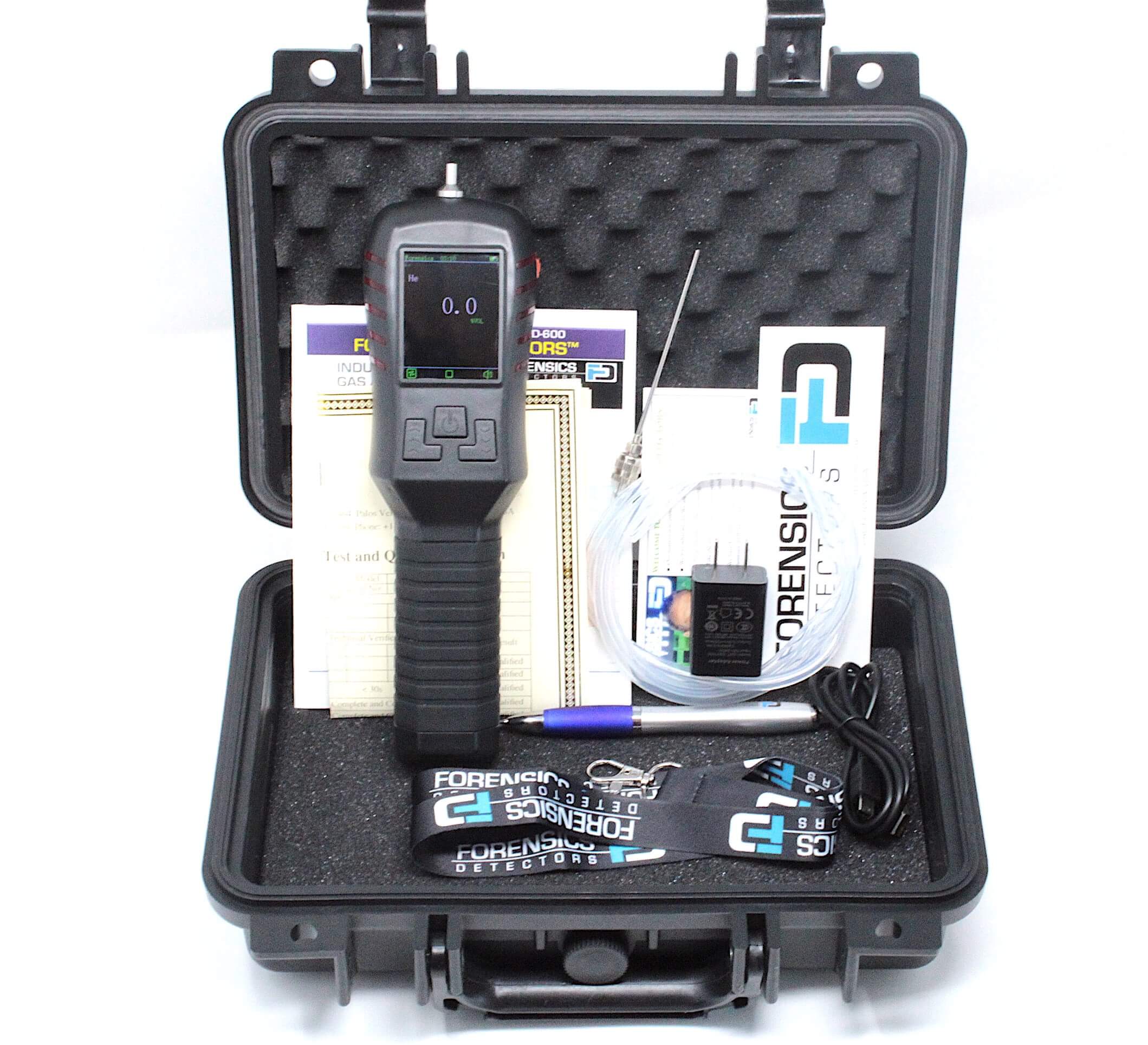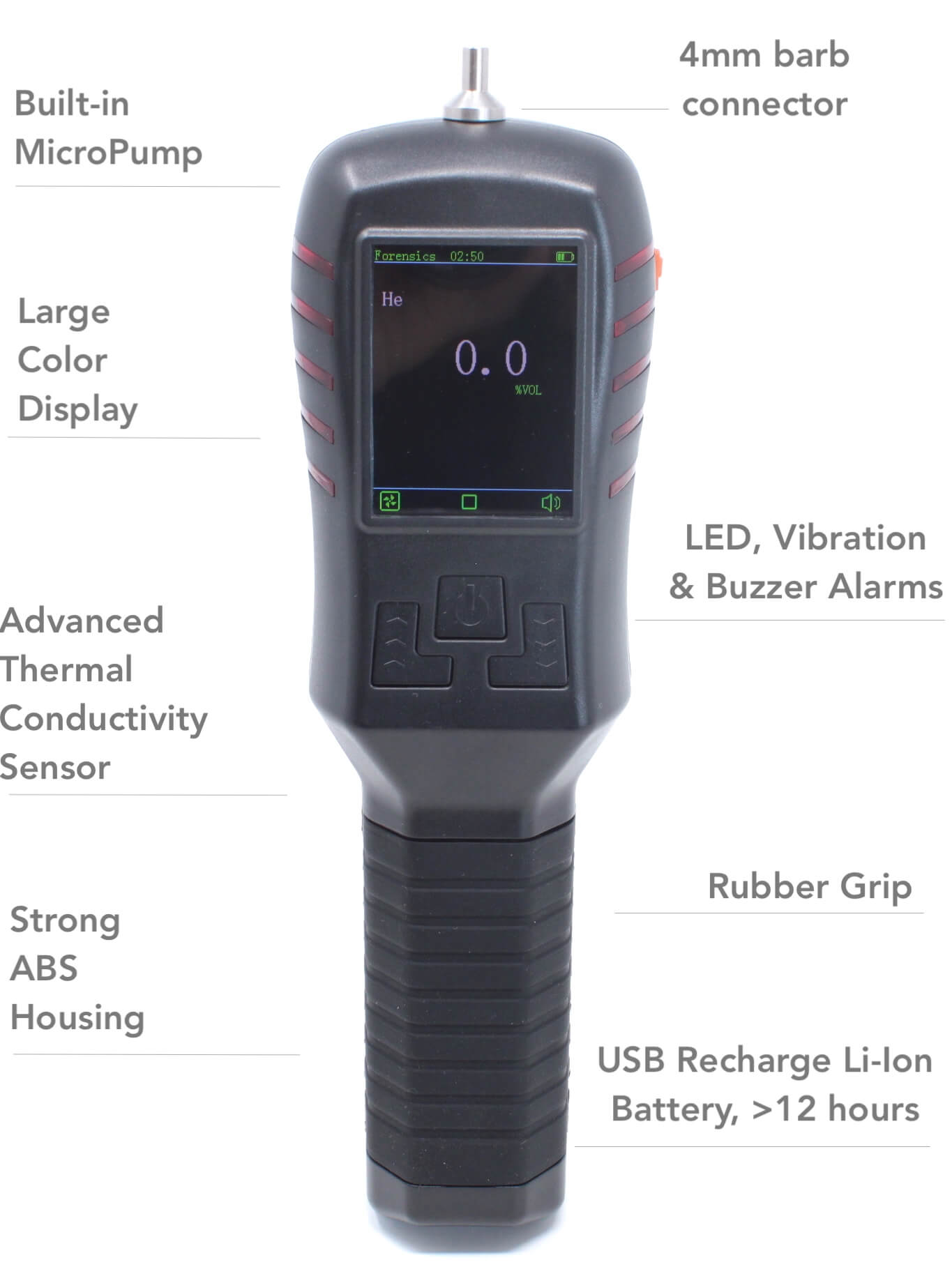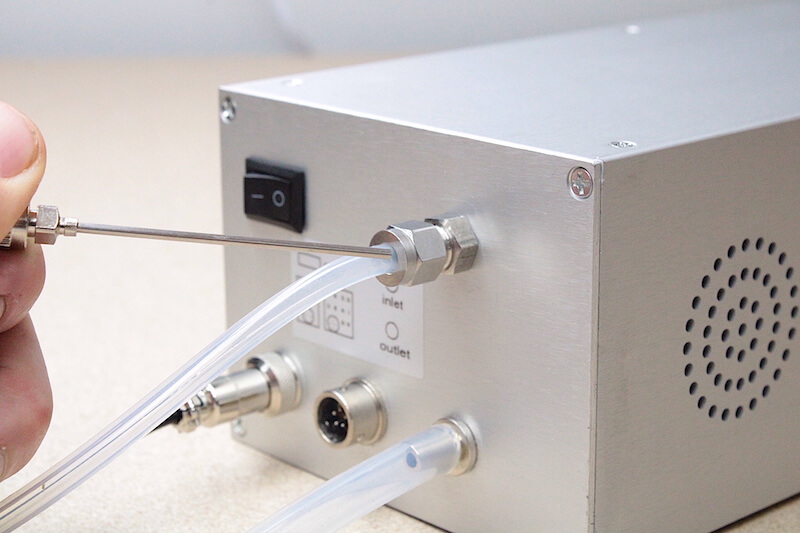Helium Leak Detector
Brand: FORENSICS DETECTORS
Model: FD-311-He
User Manual: Click Here
Blog Article: Click Here
Features




Specifications
Helium Gas (He): 0 - 100% with 0.1% resolution
Accuracy: ≤±2% F.S.
Response time: ≤ 20 sec
Display: High-Resolution Color LCD
Alarms: LED, sound, and vibration
Operating Temp & RH: 0F - 122F, <95% RH
Battery: DC3.7V Li-battery 2000 mAh
Working & Charge Time: > 6 hours / 4 hours
Sensor life: > 10 years
Rating: IP65 & Ex ib IIB T3 Gb
Dimension/Weight: 9.5 x 2.5 x 1.7inches, 440grams
Pump Flow: 0.5 LPM
Inlet Air Barb: 5mm diameter barb
Recharge: USB (5V @ 1A)
What do you get?
- Helium Gas Analyzer
- Li-ion Rechargeable Battery
- USB Charger and Cable
- 2-inch Needle Probe
- Color English Manual
- USA Technical Support
- USA NIST calibration certificate
- Hard Carry Case

Best Helium Leak Detector?
Forensics Detectors offers a professional Helium gas analyzer that is equipped with an advanced thermal conductivity sensor and a built-in pump. The device is factory-calibrated with a NIST traceability certificate and has a detection range of 0 - 100% for He gas within 20 seconds with an accuracy of +/- 2% full-scale. The device is factory NIST calibrated from Los Angeles, CA and includes a DC3.7V Li-battery 2000mAh that allows for over 6 hours of continuous use. Additionally, the device comes with advanced features such as a high-resolution LCD, backlight high-resolution LCD, calibration features, and a built-in pump that draws your sample to increase response time and ensure constant pressure and flow for the most accurate He readings. The analyzer has a top barb that can be connected to standard tubing for leak testing or other probe types.

Why is Helium Used in Trace Gas Leak Detection?
Helium gas is very small and light making it a great carrier gas for leak detection. It is also inert so it will not react with any materials. While helium is commonly known for its use in party balloons, it plays a significant role in various industrial settings. Helium gas is widely used in applications such as welding, diving, rocket propulsion, cryogenics, MRI, processing, meteorology, and research & development.
Who Uses a Helium Leak Detector?
A helium leak detector is used by various industries to detect and locate small leaks in systems and components. Some of the industries that commonly use helium leak detectors include aerospace, automotive, HVAC, refrigeration, and semiconductor manufacturing. These industries use helium leak detectors to ensure that their systems and components are leak-free and functioning properly. Helium leak detectors are also used in research and development laboratories to test the integrity of vacuum chambers and other equipment.

What about Helium Gas Calibration?
Gas detector calibration is a technical procedure performed every 6 to 12 months to ensure your helium gas leak detector is functioning accurately. Over time, the helium sensor may drift and degrade. The only way to ensure accurate and repeatable measurements is through gas calibration.
Gas calibration involves exposing the helium analyzer to a traceable concentration of test gas. We offer a service that performs calibration for you. However, you may elect to calibrate the analyzer yourself. In that case, we have a step-by-step calibration tutorial that you can follow. The calibration kit items required include:
Calibration T-piece & Tubing
Calibration Gas (He)
Calibration Gas Regulator (C10)
What about Helium Bump Testing?
Confirming the operation of your helium leak detector is very important. To build confidence and confirm the operation, the best practice is to expose the helium leak detector to some helium gas to confirm the operation. This is called bump testing.
This is achieved with helium bump gas that is sprayed at the input port of the analyzer to induce a positive response.
If you plan to purchase the helium gas bottle and regulator, you do not need the bump gas, as the calibration gas, in this case, can also serve as the bump gas.
Any Extra Accessories Required?
All items to operate the helium leak detector comes with the unit package. However, calibration kit items do not. Additional accessories that are sold separately include:
Accessories:
Calibration T-piece & Tubing
Calibration Gas (He)
Calibration Gas Regulator (C10)
Bump Gas (Helium)
Gas Detector Stand
Gas Detector Calibration Service (single gas)
How do I use the Helium Leak Detector?
- Using the helium leak detector is a simple process. To begin, turn the analyzer on and allow it to start operating after its countdown.
- If you are undertaking leak detection, install the tubing and needle. Make sure there are no blockages.
- Undertake a quick bump test to build confidence the analyzer is functional. Here we are assuming the analyzer is within the calibration period, so we are set to go. Otherwise, get the unit calibrated if you are serious about absolute best practices for maximum sensitivity and accuracy.
- Once bump tested, take the probe and scan the area of interest. Move about 2 seconds per inch. Be patient to ensure you capture any leaking helium gas.
How Long Does the Helium Gas Sensor Last?
The good news is that the Helium Leak Detector has a solid-state thermal conductivity sensor. These sensors last between 6 to 10 years and sometimes even longer. In other words, thermal conductivity sensors last much longer than traditional electrochemical gas sensors which have a life between 2-3 years.
How Should I Store my Helium Leak Detector?
The Helium Gas Leak Detector should be stored at moderate humidity and temperature. Ideally humidity at 50%RH and at room temperature at about 70F. Store the unit in the hard waterproof case that the unit is sold with. Moderate storage temperature will ensure to maximize the life of the sensor and also ensure accurate measurements when you go to turn on the unit for operation.
Conclusion
- Helium Leak Detectors are used to detect helium gas leaks in specific applications such as MRI, welding, rocket propulsion, cryogenics, meteorology, and research and development
- Helium leak detectors are also called helium gas sniffers, helium gas analyzers, and helium gas testers.
- Helium Leak Detectors are not cheap. They are expensive items.
- Helium Leak Detectors are not purchased daily, so make sure you are well-educated and know exactly what you are getting.
Author
This article was written by me, Dr. Koz (no ghostwriters and no AI content here!). I am the President of Forensics Detectors (CA, USA). I am also a subject matter expert on gas sensor technology, gas detectors, gas meters, and gas analyzers. I have been designing, building, manufacturing, and testing toxic gas detection systems for over 20 years.... and still love it.
Email: drkoz@gasleakdetectors.com

